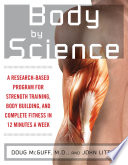

Body by Science emphasizes the effectiveness of High-Intensity Training (HIT) as a superior method for achieving fitness goals. HIT involves performing exercises at a high level of effort for a short duration, typically until muscle fatigue is reached. This approach is contrasted with traditional training methods that often involve longer durations and lower intensity. The authors argue that HIT leads to greater muscle hypertrophy and strength gains in less time, making it an efficient workout strategy. They provide scientific backing for their claims, including studies that demonstrate how short, intense workouts can stimulate muscle growth and improve metabolic health. By focusing on quality over quantity, HIT can fit into busy lifestyles, appealing to those who struggle to find time for lengthy workouts. The book also discusses the importance of recovery, suggesting that adequate rest is crucial for muscle repair and growth, which can be overlooked in conventional training paradigms.
Continue readingThe book delves into the physiological processes involved in muscle growth, explaining the role of muscle fibers, hormones, and nutrition. It discusses how resistance training leads to micro-tears in muscle fibers, which then repair and adapt to become stronger and larger. The authors highlight the significance of protein synthesis and the anabolic window, emphasizing the need for proper nutrition to support muscle recovery and growth. Additionally, they cover the importance of hormones such as testosterone and growth hormone in the muscle-building process. By understanding these biological mechanisms, readers can better appreciate how their bodies respond to exercise and the importance of integrating proper dietary practices alongside their training regimen.
Continue readingOne of the central themes of Body by Science is the idea that effective workouts do not need to be time-consuming. The authors propose that a well-structured HIT program can yield significant results in as little as 30 minutes a week. This is particularly appealing for individuals with busy schedules who may find it challenging to commit to long hours at the gym. The book outlines specific workout protocols that maximize efficiency, including guidelines on exercise selection, intensity, and frequency. By advocating for shorter, more focused workouts, the authors challenge the conventional wisdom that longer workouts are inherently better for fitness, providing a refreshing perspective for readers seeking to optimize their time spent exercising.
Continue readingRecovery is a critical component of the fitness process that is often underestimated. Body by Science emphasizes that muscles need time to recover and adapt after intense workouts. The authors explain that overtraining can lead to injuries and hinder progress, making it essential to incorporate rest days and listen to one's body. They provide insights into how sleep, nutrition, and stress management play vital roles in recovery. By prioritizing recovery, individuals can maximize their workout results and enhance their overall health. The book also discusses the psychological aspects of recovery, encouraging readers to adopt a holistic approach to fitness that includes mental well-being as part of their training regimen.
Continue readingBody by Science advocates for personalized training programs tailored to individual goals, fitness levels, and needs. The authors argue against the one-size-fits-all approach commonly seen in fitness routines, emphasizing that what works for one person may not work for another. They encourage readers to assess their unique circumstances, including physical capabilities, time constraints, and personal preferences, when designing their training programs. This individualization ensures that workouts are not only effective but also sustainable in the long term. The book provides tools and frameworks for readers to evaluate their progress and adjust their programs accordingly, promoting a proactive and engaged approach to fitness.
Continue readingThe authors of Body by Science challenge many widely accepted fitness myths and misconceptions. They question the effectiveness of traditional cardio workouts for weight loss, the necessity of daily exercise, and the belief that longer workouts are inherently better. By presenting scientific evidence and logical reasoning, the book encourages readers to think critically about the fitness advice they encounter. This skepticism is empowering, allowing individuals to make informed decisions about their fitness journeys rather than blindly following trends. The authors advocate for a science-based approach to fitness that prioritizes evidence over anecdote, ultimately fostering a more informed and discerning fitness community.
Continue readingStrength training is highlighted as a fundamental component of overall health and fitness in Body by Science. The authors discuss the myriad benefits of building strength, including improved metabolic function, increased bone density, and enhanced functional fitness. They argue that strength training should be a priority for individuals of all ages, not just those looking to build muscle. The book provides practical advice on how to incorporate strength training into one’s routine, including tips on exercise selection, form, and progression. By promoting strength training as a cornerstone of health, the authors aim to shift societal perceptions that often prioritize cardio or aesthetic goals over functional strength and well-being.
Continue reading